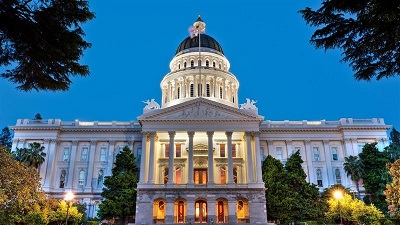The Governor’s Administration keeps a promise for transit funding amidst a wide range of state budget uncertainties.
By Arianna Smith
Managing Editor
Transit California 
Governor Newsom has made public his 2025-26 initial state budget proposal.
For now, transit agencies have reason to feel cautious optimism: the Governor’s proposal retains the multibillion-dollar commitments of the past two years’ budget cycles for ongoing transit recovery.
However, “cautious” is the critical word: global economic uncertainty, natural disasters, and delayed tax filing may result in budget conditions that require reconsideration of the Governor’s proposed expenditures.
Here’s where the 2025-26 budget process is now, and here’s what Association members can expect in the coming months.
The state of the state budget
Over the past year and as late as November 2024, experts saw signs of a looming budget deficit beginning in or after 2025. In December 2024, expected tax returns came back with $16 billion more revenue than had been long projected, resulting in a surplus of $363 million.
“Continued global instability and the prospect of another downturn in the financial markets, as well as additional pressure on state expenditures, are warning signs to remain vigilant and prudent,” said Governor Newsom of his proposed budget on January 10. “We will continue to assess the state’s ongoing fiscal position and include appropriate adjustments in the May Revision. I look forward to working with new and returning members of the Legislature on a final FY 2025-26 budget that assures California a strong economic future well into the 21st century.”
Just before the Governor released his proposed January 10 budget, the state experienced what is anticipated to become amongst the most devastating, costliest wildfires in state history, currently projected to cost as much as $135 billion. Additionally, near-term tax revenue amounts will be difficult to predict now that the Governor has offered extensions for Los Angeles County tax filing deadlines for individuals, businesses, and properties. More fire weather is on the way, and uncertainty surrounds the response of federal assistance amidst the change in Administration.
In late January, the Legislature and Govenor Newsom acted on a package of wildfire special session bills that will provide up to $2.5 billion in state funding for wildfire response and recovery in addition to the funds directed through the Governor’s emergency authority. The Legislature is expected to take action through the special session on other wildfire-related actions during April, two months before the Constitutional mandate for approval of the FY 2025-26 regular budget.
Proposed transit budget details
After months of concerns over the possibility of proposed cuts to essential services and programs, California transit agencies are relieved to hear that the Governor’s proposed 2025-26 budget maintains the $5.1 billion investment in flexible capital and operations funding first secured by the Association and stakeholder allies in the Budget Act of 2023 and later modified i the Budget Act of 2024 (SB 125 program).
The $5.1 billion agreement includes investments in the formula-based Transit Intercity Rail and Capital Program (TIRCP), totaling $4 billion, and Zero-Emission Transit Capital Program, totaling $1.1 billion. To date,the state has appropriated a total of $3 billion for the formula-based TIRCP and $410 million for the ZETCP in FYs 2023-24 and 2024-25;the remaining $1 billion for the formula-based TIRCP is set to be appropriated during this budget cycle. If the full proposal is approved by the Legislature and signed by the Governor in June, the proposed FY 2025-26 budget would bring the total level of funding appropriated toward the transit funding agreement to $4.41 billion (out of the total $5.1 billion).
The Governor’s budget also maintains the funding plan approved in the Budget Act of 2024 for the formula-based Zero-Emission Transit Capital Program (ZETCP), which approves $690 in appropriations in FYs 2026-27 and 2027-28.
The proposed budget for FY 2025-26 also maintains or provides additional funding for transit-adjacent programs in transportation, homelessness, and housing. The Governor’s proposal maintains previously committed funds of $100 million for the Active Transportation Program. The proposal also indicates the Governor’s intent to extend the Cap-and-Trade program beyond 2030, though no specifics for the extension were offered, and proposes $25 million in one-time funding to the Clean California Program for a Community Cleanup and Employment Pathways Grant Program.
“The Association will ramp its advocacy efforts to ensure that funding for the formula-based TIRCP and ZETCP continue to move forward, as proposed, and will continue to work with the Governor's Office and the Legislature to advance the priorities set forth in our newly established Cap-and-Trade Reauthorization Subcommittee,” said Michael Pimentel, Executive Director of the Association, after the Governor’s Administration released the budget proposal.
What happens now?
Now that Governor Newsom’s proposed budget has been released, the Association’s advocacy focus will expand to the Senate and Assembly Budget Committees. Budget Subcommittees, many led by newly elected legislators as their Chair, will meet to consider the Governor’s proposal and add the Legislature’s budget priorities. In particular, Association leadership will work with the Senate Budget Subcommittee No. 5 on Corrections, Public Safety, Judiciary, Labor and Transportation and new Chair Laura Richardson, as well as the Assembly Subcommittee No. 4 on Climate Crisis, Resources, Energy and Transportation and Chair Steve Bennett.
During this time, the Governor’s Administration will keep the Legislature and the public informed of changes to projected revenues and expenditures, and in mid-May, the Governor will release the “May Revise” proposed budget update. The legislation that enacts the main budget, the Budget Bill, must be passed by the full Legislature by June 15.
As work accelerates in the Budget Subcommittees in the coming months, the Association’s Advocacy and Communications Teams will provide guidance, talking points, and public affairs content for member agencies to work together with a powerful and consistent message during this year’s budget conversation.